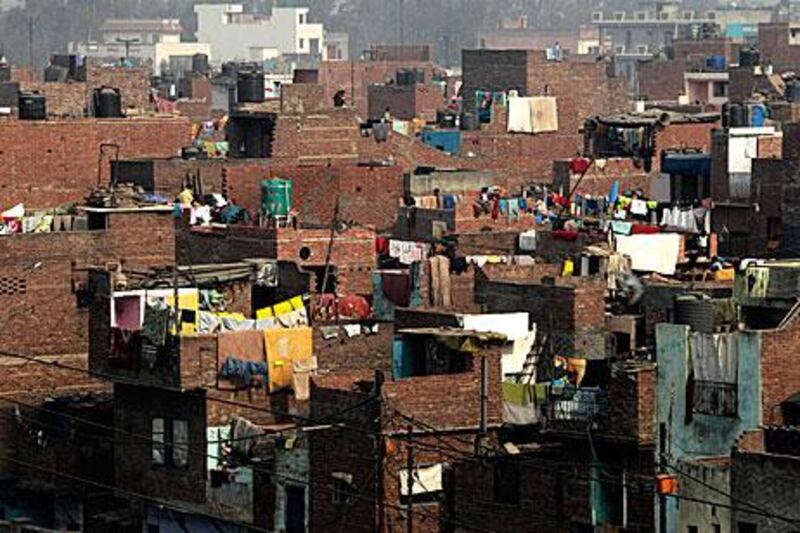NEW DELHI // The ramshackle neighbourhoods of north-eastern Delhi are home to 2.2 million people packed along narrow streets. Buildings are made from a single layer of brick. Extra floors are added to dilapidated buildings not meant to handle their weight. Tangles of electrical cables hang precariously everywhere.
If a major earthquake were to strike India's capital, these neighbourhoods - the country's most crowded - would collapse into an apocalyptic nightmare. Waters from the nearby Yamuna River would turn the water-soaked subsoil to jelly, which would intensify the shaking.
The Indian government knows this and has done almost nothing about it.
An examination of government documents spanning five decades revealed a pattern of warnings and recommendations that have been widely disregarded. Successive governments made plans and promises to prepare for a major earthquake in the city of 16.7 million, only to abandon them each time.
Delhi, which sits near a highly seismically active area, is ranked four out of five on a seismic threat scale used in India.
The Delhi government's own estimates say nine out of every 10 buildings in the city are at risk of moderate or significant quake damage, yet the basic disaster response plan it had promised to complete nearly three years ago remains unfinished, there are nearly no earthquake awareness drills in schools and offices and tens of thousands of housing units are built every year without any earthquake safety checks.
Fearing many of the city's buildings could lie in ruins after a quake, the Delhi government began work in 2005 with US government assistance to reinforce just five buildings - including a school and a hospital - it would need to begin a rudimentary relief operation to deal with the dead, wounded and homeless. Six years later, only one of those buildings is ready to cope with an earthquake.
"At the end of the day, people at the helm of affairs are not doing anything," said Anup Karanth, an earthquake engineering expert.
In its attitudes to disaster preparedness, India is like many other poor nations - aware of the danger but bogged down by both inertia and more immediate demands on its resources.
But Delhi faces immense earthquake risks. Last September, two minor jolts sent thousands of scared residents into the streets, and experts have said a big one looms on the horizon.
As far back as 1960, after a moderate quake cut power and plunged Delhi - then a city of 2.7 million - into darkness, the Geological Survey of India advised that all large buildings in the capital needed to have a plan for earthquake safety.
A series of reports by other agencies have expanded on that conclusion in recent years, but both the city and national governments have ignored almost all of the recommendations.
Some reports were ignored because of apathy, others because of shifting priorities. In a city and country growing at lightning speed with major problems of poverty and hunger that need more immediate solutions, earthquake preparedness has simply never been at the top of the list. That's what happened to the 2005 plan to prepare five important buildings in the capital for an earthquake.
Government engineers were sent to California to train. But the following year - with only the school made earthquake ready - all the engineers were taken off the project. They were reassigned to build stadiums for the 2010 Commonwealth Games, said M Shashidhar Reddy, the vice chairman of India's National Disaster Management Agency.
Just last year, a Delhi government agency ordered all new home buyers to get a building safety certificate that would mark their homes as structurally sound before registering property. But it later withdrew the order, saying there weren't enough engineers trained to conduct such inspections.
"That's like saying let's not have any traffic rules because we don't have enough policemen," said Hari Kumar, who heads Geohazards India, an organisation that promotes earthquake awareness.
Contractors routinely flout regulations, use substandard material and add illegal floors to buildings, while bribing government inspectors to look the other way, said Mr Reddy, the disaster management official. A 2001 quake in the state of Gujarat killed more than 13,000.
Geologists believe the Central Himalayan Gap, a 500-kilometre stretch between Nepal and India, is ripe for a major quake. A 6.8 quake along the fault in March 1999 damaged many buildings in Delhi, just 200km to 500km from the gap.
Studies have shown such a large build-up of energy that a shifting of the tectonic plates could cause an 8.7-magnitude earthquake, said Roger Bilham, a geologist at the University of Colorado, Boulder.
It was India's Department of Meteorology that found north-east Delhi particularly vulnerable in an unreleased 2005 study.
Meanwhile, many residents do not realise the danger, or wrongly believe they are safe from it.
When earthquake engineering expert, Mr Karanth, decided to buy an apartment in 2010, he picked a builder who promised to deliver an earthquake-resistant building. Last year, he realised the project had none of the promised earthquake safety features. "This is not one or two apartments that I'm talking about. These are thousands of apartment units being constructed," he said.
He complained and demanded an explanation.
Instead, the construction company offered to give him back his deposit.





